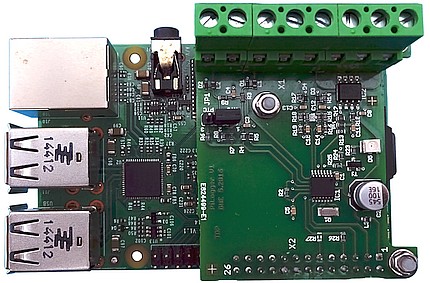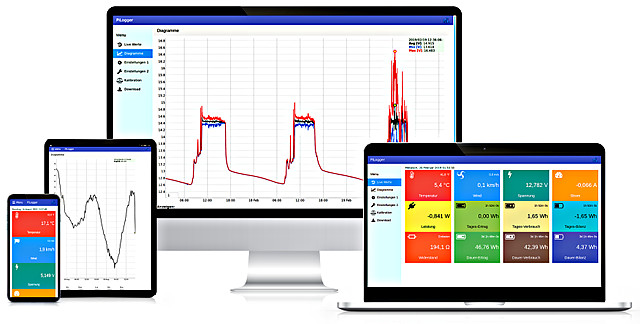PiLogger WebMonitor is free of charge and free open source software, it runs on the Raspberry Pi enabling monitoring and logging with the PiLogger One via the network - without cloud and foreign servers.
PiLogger WebMonitor turns the Raspberry Pi into a small web server, which is accessible via the home network. By that any device which is connected to your home network can display the recent values, show charts of the time line, download the data logs and control all settings just by using a browser.
The design is 'responsive' , so the presentation is adapted to the actual display size. For example the live value page:
The PiLogger provides a loop through input for combined measurement of voltage and current at its screw terminals. The respective terminals are labeled 'In+' , 'In-' and 'Out+' , 'Out-'. The internal circuit diagram looks like this:

Features
- Voltage Measurement (DC)
- Current Measurement (DC)
- Pulse Counter
- Temperature Mesurement
- Power Calculation (DC)
- Average, Minimum & Maximum
Acquisition for each channel - Own Time Base
- Solid Screw Terminals up to 4 mm²
Measuring the wind speed with the Raspberry Pi using the PiLogger is very easy.
The PiLogger provides a special input which is compatible with a lot of valuable wind sensors. Those sensors have in common to output pulses. This also is true for many other 'rate' sensors, for instance flow meters (e.g. for water) or turn speed meters.
The PiLogger is equipped with a pulse count input which is designed for the direct connection of sensors with Reed contacts (magnetically operated mechanical switches) or OC (Open Collector) or OD (Open Drain). With this Reed contacts provide the advantage not to need additional sensor power supply, while those switches are optimally protected in a little glass tube - so they will work properly for a very long time.
With the PiLogger you are also able to measure electric energy consumption - with some restrictions...*
Talking about electricity metering means you want to know how much electric energy a certain device is consuming (or generating) within a certain time. The amount of energy is derived from the product of power times the time difference.
Therefore, to measure the energy you have to integrate up the consumed or delivered power for the respective time interval. If the power is constant within this time span, it is sufficient to perform one measurement of the momentary power for this time span. But normally the power will fluctuate and it is necessary to measure it repeatively within the time span and to calculate an average value.




